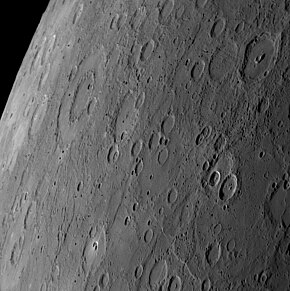 Photo from MESSENGER's first flyby in January 2008 with Glinka at bottom center | |
| Feature type | Impact crater |
|---|---|
| Location | Beethoven quadrangle, Mercury |
| Coordinates | 14°50′N 112°33′W / 14.83°N 112.55°W |
| Diameter | 89 km (55 mi) |
| Eponym | Mikhail Glinka |
Glinka is a pit-floored crater on Mercury, which was discovered in 1974 by Mariner 10 spacecraft.[1] It was named by the IAU in 2008, after Russian composer Mikhail Glinka.[2]
Its floor is covered by the smooth plain material and displays a kidney-shaped collapse feature, which is also called a central pit. The size of the pit, which was first noticed in MESSENGER images obtained in January 2008, is 20 × 8.5 km.[1] It is surrounded by a bright pyroclastic deposit. Such a feature may have resulted from collapse of a magma chamber underlying the central part of the crater. The collapse feature is an analog of Earth's volcanic calderas.[1]
-
Glinka crater
-
Closeup of the central pit
- ^ a b c Gillis-Davis, Jeffrey J.; Blewett, David T.; Gaskell, Robert W.; Denevi, Brett W.; Robinson, Mark S.; Strom, Robert G.; Solomon, Sean C.; Sprague, Ann L. (2009). "Pit-floor craters on Mercury: Evidence of near-surface igneous activity". Earth and Planetary Science Letters. 285 (3–4): 243–250. Bibcode:2009E&PSL.285..243G. doi:10.1016/j.epsl.2009.05.023.
- ^ "Glinka". Gazetteer of Planetary Nomenclature. IAU/NASA/USGS. Archived from the original on 28 September 2022. Retrieved 25 September 2022.

